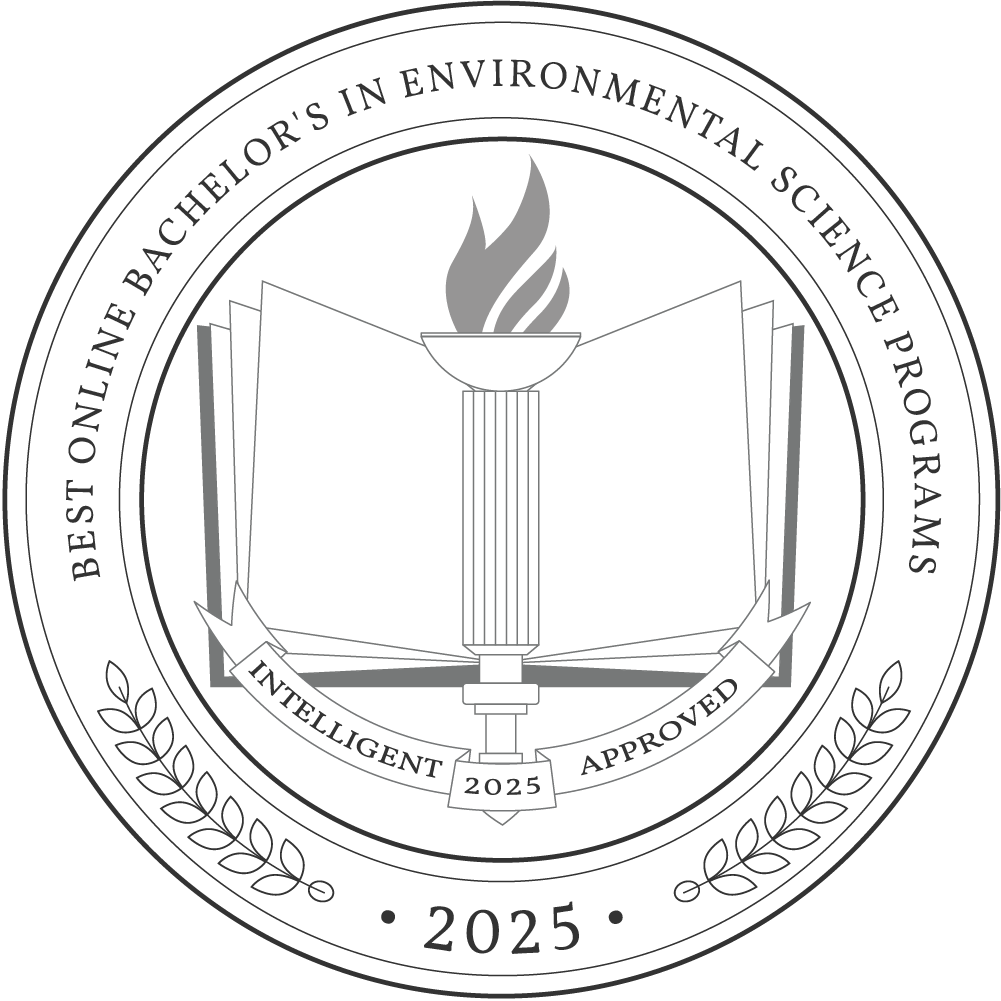Earning your online bachelor’s in environmental science can be a transformational educational experience, with many programs available to equip students with a strong foundation in ecological principles and sustainability practices. Graduates are prepared for unique roles such as Conservation Scientists, with a median yearly salary of $63,750, or Environmental Scientists, with a median annual salary of $76,530.
The flexible nature of online learning allows students to complete their degree in approximately four years. While costs vary depending on the institution, tuition at public colleges averaged $19,374 for the 2020-2021 academic year. Private universities were more expensive, averaging $45,920 the same year.
Typically, bachelor’s in environmental science degrees require around 120 credits, and most full-time students can complete a degree in four years. Students studying part-time may take longer to complete.
How to Choose an Online Bachelor’s in Environmental Science Program
Choose your area of study
It’s essential to tailor your specialization choice to your interests, as it will shape your academic journey and pave the way for a fulfilling career in the environmental field.
Consider exploring specializations like Environmental Policy and Advocacy if you’re enthusiastic about influencing environmental legislation and creating impactful change. For aspiring researchers, Environmental Biology and Ecology can offer opportunities to study ecosystems and biodiversity. Students interested in sustainable development and resource management may find their niche in Environmental Sustainability.
If you still need to decide which specialization may be best for you, pursuing a general undergraduate degree in Environmental Science is a great option. General degrees are an excellent way to get a comprehensive education in the field.
Research schools and programs
Now that you have chosen a specialization, researching schools and programs is essential to find your best fit.
Start by compiling a list of universities and colleges known for their strong programs in your ideal field. Utilize online resources to explore curriculum details, the faculty who teach there, and available research opportunities. Look for schools with relevant industry connections and internships to gain practical experience. Lastly, reach out to current students or alumni through social media or forums to gain insights into their experiences. Virtual campus tours and online information sessions can also provide a glimpse into the academic environment.
Prepare for tests and applications
Once you have a short list of the schools and programs you plan on applying to, it’s time to set your sights on performing well on standardized tests and securing your seat in the program of your choice.
First, familiarize yourself with your desired institution’s admissions and test requirements. Balance is key, so create a study schedule to balance academic commitments and test preparation. Utilize online resources, practice exams, and review materials regularly to reinforce your knowledge. For some students, an ACT or SAT test prep course is helpful. Focus on writing an engaging personal statement that highlights your dedication and resonates with the program’s ethos.
Lastly, don’t hesitate to seek guidance from mentors or admissions counselors to refine your application. Diligent preparation will increase your chances of admission into your ideal program.
Select your program
After receiving acceptance letters, you now have an exciting decision to make. Begin by revisiting each program’s curriculum, faculty, and available resources. Consider research opportunities, internship placements, and industry connections. Evaluate the program’s reputation and success of alumni in relevant fields. Ultimately, choosing the right program involves aligning your academic and career goals with a program that fosters personal growth and empowers you to make a positive impact in environmental science.
Determine how you’ll pay for your degree
Successfully funding your undergraduate degree in environmental science requires careful financial planning. Start by exploring scholarships and grants specific to environmental science offered by universities, private organizations, or government entities. Pay close attention to eligibility criteria and application deadlines to align yourself with opportunities that are ideal for you.
Fill out the Free Application for Federal Student Aid (FAFSA) to access federal aid — including grants, work-study opportunities, and low-interest loans. Some students can balance part-time work or internships to supplement their income.
Best 50 Accredited Online Bachelor’s in Environmental Science Programs

Discover More Options
How we rank schools
This list features some of the best online bachelor’s in environmental science programs in the U.S. All programs are offered by nonprofit, accredited institutions. The list includes public and private institutions known for high standards of academic quality.
Each program was evaluated on factors, including tuition costs, faculty, student resources, reputation, admission, retention, and graduation rates. Based on this, we gave each program an Intelligent Score ranging from 0 to 100. Read more about our ranking methodology.
We also compared our picks to a list of aggregated college rankings from reputable publications like the U.S. News & World Report, among others, to simplify a student’s college search. We pored through these rankings so students don’t have to.
What Can You Expect from an Online Bachelor’s in Environmental Science Program?
An online bachelor’s in environmental science offers aspiring environmentalists a comprehensive understanding of the Earth’s ecosystems, sustainability principles, and environmental challenges. Throughout the program, you’ll delve into diverse subjects such as climate change, conservation, pollution control, and resource management, fostering critical thinking and problem-solving skills for tackling real-world environmental issues.
The flexible nature of online learning allows you to study at your own pace, but typically, these programs take four years to complete. While most coursework is delivered online, some programs may include in-person workshops or residencies to enhance hands-on experience and foster networking opportunities.
Potential courses you’ll take in an online bachelor’s in environmental science program
- Environmental Biology: A requirement in virtually every undergraduate Environmental Science program, courses in Environmental Biology encourage students to immerse themselves in the intricate web of life — exploring ecological concepts, biodiversity, and interdependence of organisms within ecosystems. Through hands-on activities and virtual lab simulations, learners gain insight into the fundamental biological processes that shape the natural world.
- Climate Change and Global Sustainability: Another frequent core requirement, this course delves into the pressing issue of climate change and its impact on global ecosystems. Students analyze data, models, and research to comprehend the causes and consequences of climate change while exploring potential mitigation and adaptation strategies to promote a sustainable future.
- Environmental Policy and Change: Students examine the complex legal frameworks and policies that govern ecological conservation and protection. By styling landmark legislation and international agreements, aspiring environmentalists learn how to navigate the regulatory landscape and advocate for environmentally responsible practices.
- Renewable Energy Systems: This course focuses on renewable energy sources and their role in addressing energy demands while reducing environmental impacts. Students explore solar, wind, hydro, and geothermal energy technologies, understanding their implementation, efficiency, and potential as alternatives to fossil fuels.
What Can I Do With an Online Environmental Science Degree?
An online degree in environmental science is an ideal fit for students who have an interest in the natural world and the various disciplines related to studying it, including biology, ecology, geology, and chemistry.
Graduates with this degree can pursue careers in a variety of environmental science-related fields, such as climate change analysis, environmental health and safety planning, environmental restoration and reclamation, and industrial ecology. They may work in local, state, or government agencies, engineering firms, non-profits, and scientific companies.
While many jobs are available to individuals with a bachelor’s in environmental science, this degree can also be used as a foundation for further study in areas like environmental management, environmental engineering, or sustainability, which can lead to management and executive positions.
Career outlook
- Environmental scientists and specialists — Use their knowledge of the natural sciences to protect the environment and human health, with tasks including cleaning up polluted areas, advising policymakers, or working with industry to reduce waste.
- Median annual salary: $78,980
- Projected employment growth (through 2032): 6%
- New jobs projected: 6,900 per year
- Conservation scientists and foresters — Manage the land quality of forests, parks, rangelands, and other natural resources.
- Median annual salary: $68,750
- Projected employment growth (through 2032): 4%
- New jobs projected: 3,000 per year
- Geoscientists — Study the physical aspects of the Earth, such as its composition, structure, and processes, to learn about its past and present and to predict future events.
- Median annual salary: $92,580
- Projected employment growth (through 2032): 5%
- New jobs projected: 2,200 per year
Online Bachelor’s in Environmental Science Degree Frequently Asked Questions
How do I apply to an online bachelor’s in environmental science degree program?
Most online bachelor’s in environmental science degree programs feature a straightforward application process. Check the program’s website for specific admission requirements, including a high school diploma or equivalent, transcripts, and standardized test scores. Submit any requested documents and a thoughtfully written personal statement showcasing your dedication to environmental science.
Before submitting your application, contact an admissions counselor to gain valuable insights into the program, its curriculum, and any additional requirements. Your admissions counselor can guide you through the application process, ensuring a smooth transition into your academic pursuits.
How much does an online bachelor’s in environmental science degree cost?
The cost of an online bachelor’s in environmental science varies depending on the institution and program. As of the 2020-2021 academic year, the average tuition of these programs was $25,910. However, online programs may offer cost-saving benefits, such as reduced commuting and housing expenses. Additionally, students may save on textbooks through digital resources.
In contrast, in-person programs might incur higher tuition due to facility and resource costs. It’s crucial to consider potential fees, technology requirements, and access to field experiences to comprehensively evaluate the overall costs associated with earning your degree.
How long does it take to earn an online bachelor’s in environmental science degree?
While certain factors can cause this figure to vary — such as your enrollment status and the program’s number of required credits — most full-time students can finish in four years, completing around 120 credits. However, part-time students might take longer, as they often balance coursework with other responsibilities, like a full-time job.
It’s also important to note that the flexibility of online learning allows some students to accelerate or decelerate their pace at their leisure. On-campus degrees may have similar credit requirements, but the rigid class schedules can make it more challenging to adjust completion time. Ultimately, your individual preferences and circumstances will influence the length of your program.
Is an online environmental science degree worth it?
As governments and private entities continue to focus on sustainability practices and mitigating the effects of climate change, individuals with knowledge of environmental science will be in high demand to assist with these efforts. The Bureau of Labor Statistics predicts that employment of environmental scientists will increase by 6% through 2032, with an average of 6,900 new jobs expected each year.
Environmental science can also be a lucrative field, with an average annual wage of $78,980. Depending on the specific sector of the industry individuals work in, they can expect an even higher salary. For example, environmental scientists who work for the federal government make a median annual salary of $109,120.

